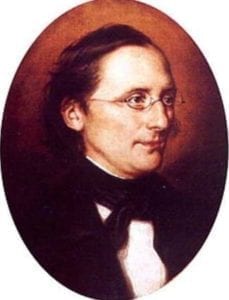 |
Carl Ludwig (1816 -1895), one of the greatest physiologists of the nineteenth century, made important contributions to a variety of disciplines. An activist in his youth, he found it necessary at one stage to switch medical schools; and also while a student became interested in fencing, which accounts for a prominent scar on his upper lip. Graduating from the University of Marburg in 1840, he first worked in the laboratory of Robert Bunsen, then became a prosector in the department of anatomy.
In 1842, while in Marburg, he published his important paper on the function of the glomerulus. In this he disagreed with William Bowman, who two years earlier had postulated that only water passed through the glomerulus itself and that all solutes were added by tubular secretion. By contrast, Ludwig postulated that hydrostatic forces caused a filtrate to pass through the glomerulus and that this was partially reabsorbed by the tubules. The role of tubular secretion remained controversial for the next eighty years and was not settled until Cushny’s modern theory that postulated both tubular reabsorption and secretion.
Also in 1842, Ludwig began work on measuring blood pressure. In 1847 he invented the kymograph, a revolving drum wrapped with a sheet of paper on which a stylus moved to record changes in pressure or motion. He also developed the stromuhr, a device that recorded the velocity of the blood in arteries and veins. Appointed professor and chairman of the anatomy department in Zürich in 1849, he taught anatomy and wrote a textbook on physiology. In 1855 he became professor of physiology and zoology in Vienna, and there invented a mercurial blood gas pump for the separation of gases from the blood, allowing him to study gas transfer in the lungs. He also investigated the formation of saliva, of lymph, the mechanics of circulation of blood gases, and the origins of a vasomotor in the medulla.
In 1865 he was appointed chair of physiology at the new Institute of Physiology in Leipzig. There he worked for ten years, continuing his work on the regulation of the circulation and on respiratory gas transport. He carried out work on the viability of isolated and perfused hearts, kidneys, and livers, as well as on the physiology, histology and biochemistry of blood lymph and muscle. He also studied diuresis, anesthesia, heart valves, the origins of the first heart sound, the salivary glands, and pancreatic secretion. He introduced the measurement of nitrogen in the urine as an indication of the rate of protein metabolism and was first to show that human digestive glands were influenced by secretory nerves. During his career he received many honors and trained many students, some of whom later made important contributions to physiology and medicine. In Leipzig the Carl Ludwig Institute is named after him. He died in 1895.
GEORGE DUNEA, MD, Editor-in-Chief

Leave a Reply